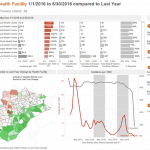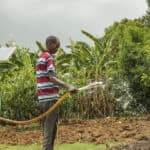A Business Opportunity With Exponential Benefits: Linking Agriculture and Energy to Improve Livelihoods in Africa
Agriculture drives sub-Saharan Africa’s economies, contributing around 23% of the region’s GDP. And access to energy can help drive agricultural development. There are substantial untapped business opportunities in linking investments and enterprises in the energy and agriculture sectors to create exponential benefits. Electrifying production practices in the agriculture space can reduce costs, improve productivity and boost livelihoods in rural communities. It can also ensure the stable demand that energy companies need to provide clean, reliable and affordable electricity service in these communities.
But while early adopters are at the forefront of testing and developing business models for productive energy uses in sub-Saharan African agriculture, these businesses are currently the exception and not the norm. Meanwhile, the lack of access to electricity and the mechanization it enables is limiting value addition and growth in the rural communities that represent the backbone of agricultural production.
RMI aims to bring light to the opportunities that exist for agribusinesses that successfully link their investment and other business decisions with energy considerations – and for energy businesses that link their efforts to agriculture. Below, we’ll explore some examples of businesses that are executing this approach successfully.
A Commercial Opportunity with Exponential Benefits
A thriving market for electric agricultural equipment powered by clean energy sources provides compelling benefits to its end-users, and to the broader sector and economy. Replacing inefficient, fossil fuel-powered equipment with efficient electric versions can be an attractive investment. For instance, in Ethiopia, we found that switching from a diesel- or petrol-powered mill to an electric mill can reduce mill operators’ energy costs by almost 50%, while doubling their profit margins.
We observed similar opportunities in Nigeria, where we found that switching from a one-stage diesel rice mill and diesel cassava grater to a two-stage electric rice mill and electric cassava grater can generate an internal rate of return of over 150% and 70% respectively, over the lifetime of the equipment. These results hold true under a range of conservative assumptions for electricity costs and production volumes. In other words, electrifying these activities remains economically viable even if you factor in reasonable increases in electricity costs and decreases in production volumes.
Transitioning from fossil fuel-powered equipment to renewable energy-powered electric alternatives also offers other benefits. It significantly reduces the burden, costs and time of traveling to procure fuel. Plus, it alleviates concerns about fuel price fluctuations that affect profitability.
Beyond the direct benefits to end-users, a thriving market for electric agricultural equipment can create significant opportunities for the businesses that serve it. In the electric milling example presented above, we found that mill operators can recoup their investment in less than three years, suggesting a viable market for equipment suppliers and financiers.
Early Adopters Linking Agriculture and Energy
Early adopters are already responding to these market opportunities, testing innovative business models that bridge the skills and experience of the agriculture and energy sectors.
For instance, Imara Tech is developing a portfolio of productive-use agricultural equipment to serve off-grid farms and enable farmers to capture additional segments of the value chain in Tanzania. And BODAWERK is developing a fee-based model to provide farmers in East Africa with mechanized services, by deploying a fleet of mobile electric farming equipment like threshers, mills and tractors, available to farmers via rental. If successful, this model will boost equipment utilization and address the lack of affordability most small-scale farmers and entrepreneurs face, by transferring the responsibility of making the upfront investment to a larger operator like BODAWERK with, presumably, greater access to credit.
Clean energy providers serving productive loads (i.e., electricity demand from powering income-generating activities) in agriculture are also recognizing how these customers can reduce their costs and boost their revenues. For instance, these providers can reduce their cost-recovery tariffs (i.e., the price they must charge to recoup their investments in energy assets) by serving customers that consistently use electricity during the day, such as the above-mentioned businesses and organizations. By using lower-cost power generated by solar panels – and distributing that electricity during the daytime hours when the panels are active – they can avoid investing in expensive energy storage or diesel-powered generation. Over 70% of the grain millers we interviewed in Ethiopia operate year-round during daytime hours, making them an attractive customer category for energy providers.
Energy and maintenance service providers are also starting to seek out and serve productive loads like these. For example, the Mini-Grid Innovation Lab is helping mini-grid developers run appliance financing programs and prototype grain mills. And PowerGen is retrofitting motors to power electric mills in Nigeria: By retrofitting existing assets, it’s making the switch to electric equipment more affordable and increasing market size.
FRES is another organization that’s collaborating with agriculture actors, working to define its five-year investment strategy in Burkina Faso. An energy-providing subsidiary of this Dutch nonprofit partnered with Sowdjoma, a local shea-butter processing cooperative, to develop and co-locate energy assets with the cooperative’s pre-processing centers. This win-win partnership provides the FRES subsidiary with a stable anchor load – i.e., an electricity customer large enough to provide an energy company with enough stable demand to recoup its investment while powering surrounding homes and businesses. This enables it to size its energy systems more accurately to meet the expected electricity load, achieving lower cost-reflective prices than it would otherwise be able to offer. This partnership also ensures the agriculture cooperative’s access to reliable and affordable electricity to power and expand its operations.
Finally, 60Hertz has developed an offline computerized maintenance management system to streamline maintenance services for remote energy access assets. Although its portfolio in sub-Saharan Africa is focused on providing maintenance for mini-grid systems, the underlying technology can be expanded and scaled for other applications that require routine maintenance services, like productive agricultural equipment.
Expanding the Agriculture and Energy Business Connection
Examples like these illustrate the benefits and opportunities for businesses linking investments in the agriculture and energy sectors. But while the above-mentioned businesses and organizations are pioneers in prototyping and developing business models for productive energy uses in agriculture, these examples are rare.
There are several reasons for this. Systemic barriers, such as informational disparities and lack of access to credit, limit early adopters’ ability to transition from early-stage development to scale – and also make the market less attractive for new businesses to enter. Some businesses may lack the resources to set up a robust and systematic data collection approach that allows them to assess the viability of different models and approaches. And those companies that have the resources to do so may lack the incentives to share the lessons they learn widely, for fear that it may reduce their comparative advantage, limiting replication and market growth.
Additionally, flexible sources of funding that enable risk-taking to test and learn which models and approaches are feasible are not widely available. Without access to de-risking support, microfinance institutions and other private financiers will not finance businesses that have not been proven – so early adopters are forced to self-finance, limiting how fast they can grow. Finally, linking agriculture and energy efforts requires a combination of varied skills that are rarely found in one entrepreneur or business alone. For example, an equipment supplier developing a battery-powered mobile rice thresher may lack expertise in the end-consumer preferences and agricultural production practices that can guide prototype development.
Collaboration and Knowledge Sharing to Link Energy and Agriculture
To help companies overcome these systemic barriers and quickly scale solutions, we need an innovation program that facilitates collaboration and knowledge-sharing across the whole system. RMI is supporting partners in the Rural Electrification Agency in Nigeria; the Ministry of Water, Irrigation and Energy in Ethiopia; and in the private, academic and philanthropic fields, in order to develop targeted programs that will do just that. These partnerships are harnessing the existing momentum between the two sectors by equipping pioneering businesses with flexible funding, while providing the on-call support needed to scale, and sharing lessons learned for rapid replication. These efforts aim to support businesses in developing projects on the ground, and to quickly scale successful approaches and strategies.
Agriculture represents a major driver of the economies of sub-Saharan Africa. If we can link investments and enterprises in energy and agriculture, the commercial opportunities are immense. Entrepreneurs are well-placed to unleash this market potential, increasing profits for clean energy providers, boosting the market for equipment suppliers and improving livelihoods for farmers across Africa.
Scarlett Santana is the Director of RMI’s Global South program.
Photo courtesy of ILRI /Muthoni Njiru.
- Categories
- Agriculture, Energy



